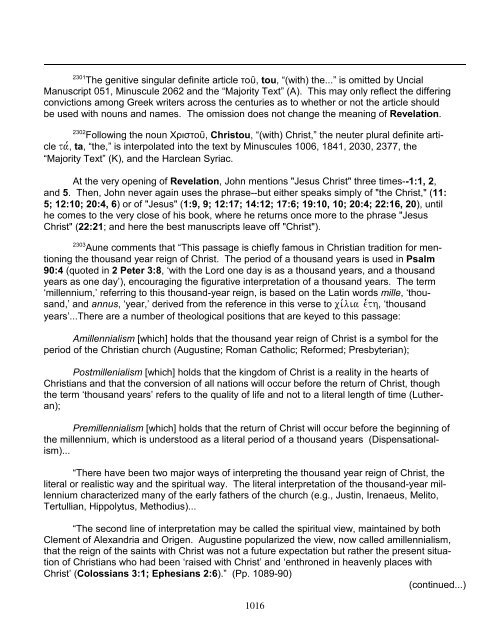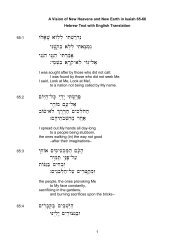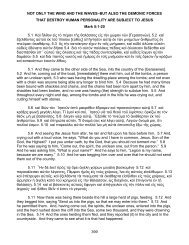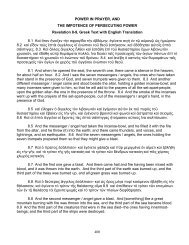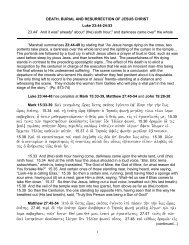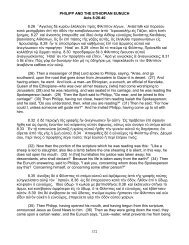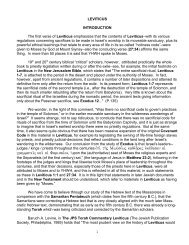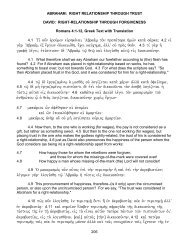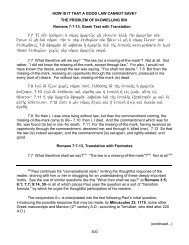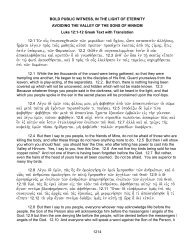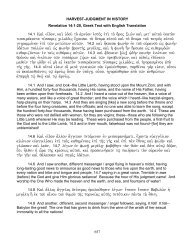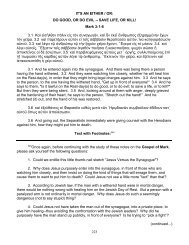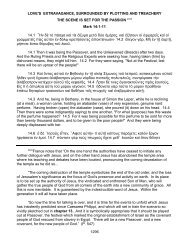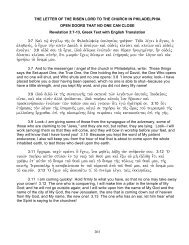Revelation 20 - In Depth Bible Commentaries
Revelation 20 - In Depth Bible Commentaries
Revelation 20 - In Depth Bible Commentaries
Create successful ePaper yourself
Turn your PDF publications into a flip-book with our unique Google optimized e-Paper software.
2301<br />
The genitive singular definite article ôï, tou, “(with) the...” is omitted by Uncial<br />
Manuscript 051, Minuscule <strong>20</strong>62 and the “Majority Text” (A). This may only reflect the differing<br />
convictions among Greek writers across the centuries as to whether or not the article should<br />
be used with nouns and names. The omission does not change the meaning of <strong>Revelation</strong>.<br />
2302<br />
Following the noun ×ñéóôï, Christou, “(with) Christ,” the neuter plural definite article<br />
ta, ta, “the,” is interpolated into the text by Minuscules 1006, 1841, <strong>20</strong>30, 2377, the<br />
“Majority Text” (K), and the Harclean Syriac.<br />
At the very opening of <strong>Revelation</strong>, John mentions "Jesus Christ" three times--1:1, 2,<br />
and 5. Then, John never again uses the phrase--but either speaks simply of "the Christ," (11:<br />
5; 12:10; <strong>20</strong>:4, 6) or of "Jesus" (1:9, 9; 12:17; 14:12; 17:6; 19:10, 10; <strong>20</strong>:4; 22:16, <strong>20</strong>), until<br />
he comes to the very close of his book, where he returns once more to the phrase "Jesus<br />
Christ" (22:21; and here the best manuscripts leave off "Christ").<br />
2303<br />
Aune comments that “This passage is chiefly famous in Christian tradition for mentioning<br />
the thousand year reign of Christ. The period of a thousand years is used in Psalm<br />
90:4 (quoted in 2 Peter 3:8, ‘with the Lord one day is as a thousand years, and a thousand<br />
years as one day’), encouraging the figurative interpretation of a thousand years. The term<br />
‘millennium,’ referring to this thousand-year reign, is based on the Latin words mille, ‘thousand,’<br />
and annus, ‘year,’ derived from the reference in this verse to ci,lia ev,th, ‘thousand<br />
years’...There are a number of theological positions that are keyed to this passage:<br />
Amillennialism [which] holds that the thousand year reign of Christ is a symbol for the<br />
period of the Christian church (Augustine; Roman Catholic; Reformed; Presbyterian);<br />
Postmillenialism [which] holds that the kingdom of Christ is a reality in the hearts of<br />
Christians and that the conversion of all nations will occur before the return of Christ, though<br />
the term ‘thousand years’ refers to the quality of life and not to a literal length of time (Lutheran);<br />
Premillennialism [which] holds that the return of Christ will occur before the beginning of<br />
the millennium, which is understood as a literal period of a thousand years (Dispensationalism)...<br />
“There have been two major ways of interpreting the thousand year reign of Christ, the<br />
literal or realistic way and the spiritual way. The literal interpretation of the thousand-year millennium<br />
characterized many of the early fathers of the church (e.g., Justin, Irenaeus, Melito,<br />
Tertullian, Hippolytus, Methodius)...<br />
“The second line of interpretation may be called the spiritual view, maintained by both<br />
Clement of Alexandria and Origen. Augustine popularized the view, now called amillennialism,<br />
that the reign of the saints with Christ was not a future expectation but rather the present situation<br />
of Christians who had been ‘raised with Christ’ and ‘enthroned in heavenly places with<br />
Christ’ (Colossians 3:1; Ephesians 2:6).” (Pp. 1089-90)<br />
(continued...)<br />
1016


